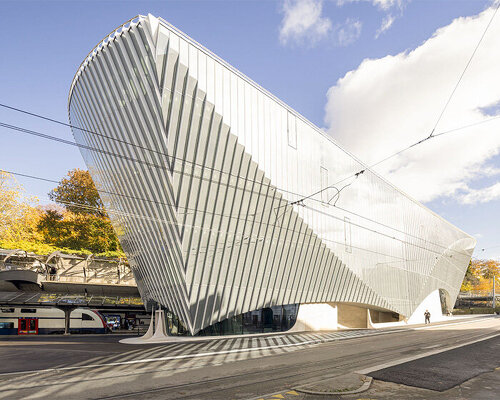santiago calatrava completes haus zum falken in zurich
In Zurich, Santiago Calatrava marks the completion of Haus zum Falken, a mixed-use building that breathes new life into the Stadelhofen Station area. Located at the eastern edge of Stadelhofer Platz, the project closes an architectural gap beside the historic main building that accommodates the station while introducing a public square, a large underground bicycle station, and light-filled interior spaces. The development (find designboom’s previous coverage here) continues Calatrava’s long-standing engagement with the area, which began in the 1980s when he designed the adjacent Stadelhofen Station. ‘The area around the Haus zum Falken is very familiar to me, as I was involved in the construction of the Stadelhofen Station here for eight years,’ he recalls. ‘That was followed by seven more stations that I had the opportunity to build in various locations.’
Calatrava describes Haus zum Falken as ‘an artistic event in the city.’ Its glass facade undulates across five levels, with vertical profiles and reflections shifting light and movement. Its articulated cornice and folded geometry lend the building a presence that changes with the time of day.
all images by Ingo Rasp
redefining stadelhofen’s urban landscape
Haus zum Falken anchors the east end of Stadelhofer Platz, completing a network of connected public spaces stretching from Lake Zurich to the Opera House and Sechseläutenplatz. Together with the Olivenbaum building to the west, it frames the historic structure of the station. A recessed ground floor creates Falkensteg Square, an open public area defined by the existing stair bridge that connects the station to the neighborhood above.
On Kreuzbühlstrasse, the eastern edge of the building introduces a small forecourt lined with greenery, offering views toward Zurich’s Grossmünster towers. One of the project’s most ambitious components lies beneath the surface. Responding to the City of Zurich’s initiative to reorganize bicycle traffic, Spanish-Swiss architect Santiago Calatrava integrated an underground bicycle station with capacity for more than 800 bikes. The three-level facility frees Stadelhofer Platz from open-air parking, returning its surface to pedestrians and urban greenery. Building this structure in the tight, waterlogged site presented major technical challenges, ultimately resolved through an intricate foundation system and waterproofing strategy. Now complete, the subterranean complex stands as a critical piece of Zurich’s sustainable mobility network.
in Zurich, Santiago Calatrava marks the completion of Haus zum Falken
light-filled interiors and environmental performance
The stone plinth of the structure extends material dialogues with Zurich’s traditional facades along Bahnhofstrasse. Slender stone pillars mark the entrances, while the facade above transitions to glass and metal. Inside, a four-story atrium and sculptural staircase form the spatial heart of the building, hosting a sinuous interior volume. The upper floors are conceived as column-free rental spaces, adaptable to varied uses. Large windows frame views toward the promenade and the city beyond, while the dense rhythm of the facade creates a sense of privacy within.
The building meets rigorous environmental standards, achieving LEED Gold certification and exceeding Minergie-P benchmarks. A photovoltaic roof generates on-site energy, and the building envelope is optimized for thermal and acoustic performance. Even with trams and trains running just meters away, interior noise remains minimal. Wood and gold-toned finishes complete the double-height foyer, echoing the rhythm of the exterior facade, creating a warm, luminous space that welcomes visitors from Stadelhofer Platz and the elevated promenade.
this mixed-use building that breathes new life into the Stadelhofen Station area
the project closes a key architectural gap beside the historic main building
introducing a public square, a large underground bicycle station, and light-filled interior spaces
the glass facade undulates across five levels
the upper floors are conceived as column-free rental spaces
the dense rhythm of the facade creates a sense of privacy within
the building envelope is optimized for thermal and acoustic performance
a four-story atrium and sculptural staircase form the spatial heart of the building
wood and gold-toned finishes complete the double-height foyer
welcoming visitors from Stadelhofer Platz and the elevated promenade
Haus zum Falken meets rigorous environmental standards, achieving LEED Gold certification
project info:
name: Haus zum Falken
architect: Santiago Calatrava | @calatravaofficial
location: Zurich, Switzerland
area: 2,275 square meters
The post santiago calatrava sculpts haus zum falken in zurich with folded glass facade appeared first on designboom | architecture & design magazine.

